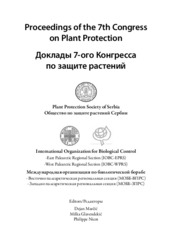Prikaz osnovnih podataka o dokumentu
Seed transmission of Xanthomonas vesicatoria and Clavibacter michiganensis subsp. michiganensis in tomato and Xanthomonas euvesicatoria in pepper and implementation of seed disinfection methods
| dc.creator | Giovanardi, Davide | |
| dc.creator | Biondi, Enrico | |
| dc.creator | Ignjatov, Maja | |
| dc.creator | Gašić, Katarina | |
| dc.creator | Ferrari, Michele | |
| dc.creator | Perez, Set | |
| dc.creator | Jevtić, Radivoje | |
| dc.creator | Stefani, Emilio | |
| dc.date.accessioned | 2024-04-23T08:42:14Z | |
| dc.date.available | 2024-04-23T08:42:14Z | |
| dc.date.issued | 2015 | |
| dc.identifier.isbn | 978-86-83017-27-0 | |
| dc.identifier.uri | http://fiver.ifvcns.rs/handle/123456789/4546 | |
| dc.description.abstract | Seed-borne bacterial pathogens of tomato and pepper are of major concern worldwide. Xanthomonas vesicatoria (Xv) and Xanthomonas euvesicatoria (Xe), the causal agents of bacterial leaf spot, and Clavibacter michiganensis subsp. michiganensis (Cmm), the causal agent of tomato bacterial canker, are worldwide distributed, but the occurrence of the latter is usually erratic. In order to evaluate the risk of seed transmission and the relationship between seed contamination and disease outbreak, an extensive field trial has been put in place in 2013 for each pathosystem. Three artificially contamination levels were considered (1%, 5% and 15% or 20%, respectively in Italy and in Serbia), composed of 100 seedlings each. Disease outbreaks were monitored weekly during the growing season until harvesting and disease was quantified by means of AUDPC. Seeds were produced from each plot and analysed in order to assess their contamination level. Preliminary results of our studies showed that disease quantity caused by Xv, Cmm or Xe was directly correlated to the percentage of initial infection, according to AUDPC values obtained. Contamination rate of seed produced in diseased fields was not always correlated with disease quantity observed. A microbial consortium, a bacterial antagonist and plant polyphenols were assayed to assess their potential efficacy in seed disinfection: naturally contaminated tomato and pepper seeds were treated and sown. Pepper and tomato seedlings were inspected and analysed for the presence of bacterial spot. Preliminary results obtained show that none of the above mentioned treatments was able to eradicate the pathogen from seeds. | sr |
| dc.language.iso | en | sr |
| dc.publisher | Beograd : Društvo za zaštitu bilja Srbije | sr |
| dc.relation | Development of seed testing methods for pests and pathogens of plant health concern (TESTA) | sr |
| dc.rights | openAccess | sr |
| dc.rights.uri | https://creativecommons.org/licenses/by/4.0/ | |
| dc.source | Proceedings, 7th Congress on Plant Protection "Integrated Plant Protection – a Knowledge-Based Step towards Sustainable Agriculture, Forestry and Landscape Architecture", 24-28 November 2014, Zlatibor | sr |
| dc.subject | bacteria | sr |
| dc.subject | seed-borne bacteria | sr |
| dc.subject | tomato | sr |
| dc.subject | peppers | sr |
| dc.subject | seed transmission | sr |
| dc.subject | seed disinfection | sr |
| dc.subject | Xanthomonas vesicatoria | sr |
| dc.subject | Clavibacter michiganensis subsp. michiganensis | sr |
| dc.subject | Clavibacter michiganensis | sr |
| dc.title | Seed transmission of Xanthomonas vesicatoria and Clavibacter michiganensis subsp. michiganensis in tomato and Xanthomonas euvesicatoria in pepper and implementation of seed disinfection methods | sr |
| dc.type | conferenceObject | sr |
| dc.rights.license | BY | sr |
| dc.citation.epage | 70 | |
| dc.citation.spage | 65 | |
| dc.identifier.fulltext | http://fiver.ifvcns.rs/bitstream/id/12088/bitstream_12088.pdf | |
| dc.identifier.rcub | https://hdl.handle.net/21.15107/rcub_fiver_4546 | |
| dc.type.version | publishedVersion | sr |


